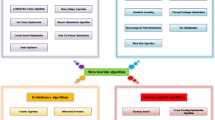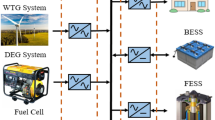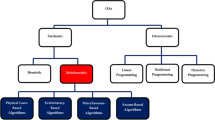Abstract
Dissolved oxygen is a critical water quality factor, and its prediction and control have long been a research hotspot in the aquaculture industry. This study aims to address the limitations of poor population diversity and the ease of falling into local optima in the basic sparrow search algorithm (SSA). Herein, we improved this methodology in many aspects and proposed a hybrid improved SSA (HISSA) to enhance optimization performance. First, in the global search process of the sparrow producer, the position update strategy is modified to enhance the global search ability of the algorithm. Second, a butterfly algorithm is incorporated to replace the position update strategy in the escape stage of the producer to promote information exchange between individuals. Third, the Cauchy mutation strategy and greedy rule are used to perturb and update the current optimal solution to improve the algorithm’s ability to jump out of local optima. The performance of the proposed HISSA was verified on 10 benchmark functions. The experimental results illustrate that the proposed algorithm outperformed the four intelligent algorithms evaluated herein. In addition, the proposed HISSA was separately applied to the parameter optimization of the two most commonly used engineering methods: the back propagation neural network (BPNN) and proportional-integral-derivative (PID) controller. Compared with other intelligent algorithm-optimized methods, the error evaluation index values of the HISSA-BPNN and HISSA-PID controllers are small, indicating that the proposed HISSA is highly effective and practical for engineering parameter optimization, and can be competent for the prediction and control of dissolved oxygen.














Similar content being viewed by others
References
Missaghi S, Hondzo M, Herb W (2017) Prediction of lake water temperature, dissolved oxygen, and fish habitat under changing climate. Clim Chang 141(4):747–757
Ren Q, Zhang L, Wei Y, Li D (2018) A method for predicting dissolved oxygen in aquaculture water in an aquaponics system. Comput Electron Agr 151:384–391
Saber A, James DE, Hayes DF (2020) Long-term forecast of water temperature and dissolved oxygen profiles in deep lakes using artificial neural networks conjugated with wavelet transform. Limnol Oceanogr 65(6):1297–1317
Duan Q, Liu Y, Zhang L (2018) State-of-the-art review for application of big data technology in aquaculture. Trans Chin Soc Agricult Mach 49(6):1–16
Rozario APR, Devarajan N (2020) Monitoring the quality of water in shrimp ponds and forecasting of dissolved oxygen using fuzzy C means clustering based radial basis function neural networks. J Amb Intel Hum Comp 12(5):4855–5862
Zhou XH, Wang JP, Cao XK, Fan YX, Duan QL (2021) Simulation of future dissolved oxygen distribution in pond culture based on sliding window-temporal convolutional network and trend surface analysis. Aquac Eng 95:102200
Cao XK, Ren N, Tian GL, Fan YX, Duan QL (2021) A three-dimensional prediction method of dissolved oxygen in pond culture based on attention-GRU-GBRT. Comput Electron Agr 181:105955
Liu YQ, Zhang Q, Sun LQ, Chen YY (2019) Attention-based recurrent neural networks for accurate short-term and long-term dissolved oxygen prediction. Comput Electron Agr 165:104964
Yin BA, Wang R, Qi SB, Yu JD, Jiang WL (2021) Prediction model of dissolved oxygen in marine pasture based on hybrid gray wolf algorithm optimized support vector regression. Desalin Water Treat 222:156–167
Wu Y, Sun L, Sun X, Wang B (2021) A hybrid XGBoost-ISSA-LSTM model for accurate short-term and long-term dissolved oxygen prediction in ponds Environ Sci Pollut R
Xiang Z, Ji D, Zhang H, Wu H, Li Y (2019) A simple PID-based strategy for particle swarm optimization algorithm. Inform Sci 502:558–574
Cao F (2020) PID controller optimized by genetic algorithm for direct-drive servo system. Neural Comput Appl 32(1):23–30
Rad AB, Lo WL, Tsang KM (1997) Self-tuning PID controller using Newton-Raphson search method. IEEE T Ind Electron 44(5):717–725
Raj R, Mohan BM, Lee DE, Yang JM (2022) Derivation and structural analysis of a three-input interval type-2 TS fuzzy PID controller. Soft Comput 26(2):589–603
Huang GM, Yuan XF, Shi K, Wu XR (2019) A BP-PID controller-based multi-model control system for lateral stability of distributed drive electric vehicle. J Franklin I 356(13):7290–7311
Pugazhenthi PN, Selvaperumal S, Vijayakumar K (2021) Nonlinear PID controller parameter optimization using modified hybrid artificial bee colony algorithm for continuous stirred tank reactor. B Pol Acad Sci-Tech 69(3):e137348
Kashyap AK, Parhi DR (2021) Particle swarm optimization aided PID gait controller design for a humanoid robot. ISA T 114:306–330
Rahman M, Ong ZC, Chong WT, Julai S, Ng XW (2019) Wind turbine tower modeling and vibration control under different types of loads using ant colony optimized PID controller. Arab J Sci Eng 44(2):707–720
Mousakazemi SMH (2021) Comparison of the error-integral performance indexes in a GA-tuned PID controlling system of a PWR-type nuclear reactor point-kinetics model. Prog Nucl Energ:132
Feng H, Ma W, Yin CB, Cao DH (2021) Trajectory control of electro-hydraulic position servo system using improved PSO-PID controller. Automat Constr 127:127
Zhang Y, Yuan LJ, Zhang Q, Sun XY (2020) Multi-objective optimization of building energy performance using a particle swarm optimizer with less control parameters. J Build Eng 32
Gao YK, Xie LB, Zhang ZD, Fan QG (2020) Twin support vector machine based on improved artificial fish swarm algorithm with application to flame recognition. Appl Intell 50(8):2312–2327
Zhang X, Zhang C, Wei Z (2019) Carbon price forecasting based on multiresolution singular value decomposition and extreme learning machine optimized by the moth-flame optimization algorithm considering energy and economic factors. Energies 12(22):4283
Haghnegahdar L, Wang Y (2020) A whale optimization algorithm-trained artificial neural network for smart grid cyber intrusion detection. Neural Comput Appl 32(13):9427–9441
Shams I, Mekhilef S, Tey KS (2021) Maximum power point tracking using modified butterfly optimization algorithm for partial shading, uniform shading, and fast varying load conditions. IEEE T Power Electr 36(5):5569–5581
Wang SL, Fernandez C, Yu CM, Fan YC, Cao W, Stroe DI (2020) A novel charged state prediction method of the lithium ion battery packs based on the composite equivalent modeling and improved splice Kalman filtering algorithm. J Power Sources 471:471
Bajaj A, Sangwan OP (2021) Discrete cuckoo search algorithms for test case prioritization. Appl Soft Comput 110:107584
Xue J, Shen B (2020) A novel swarm intelligence optimization approach: sparrow search algorithm. Syst Sci Control Eng 8(1):22–34
Gai JB, Zhong KY, Du XJ, Yan K, Shen JX (2021) Detection of gear fault severity based on parameter-optimized deep belief network using sparrow search algorithm. Measurement 185:185
Zhang C, Ding S (2021) A stochastic configuration network based on chaotic sparrow search algorithm. Knowl-Based Syst 220:220
Zhu Y, Yousefi N (2021) Optimal parameter identification of PEMFC stacks using adaptive sparrow search algorithm. Int J Hydrogen Energ 46(14):9541–9552
Ouyang CT, Zhu DL, Wang FQ (2021) A learning sparrow search algorithm. Comput Intel Neurosc 2021:1–23
Li XJ, Gu JA, Sun XH, Li J, Tang SX (2022) Parameter identification of robot manipulators with unknown payloads using an improved chaotic sparrow search algorithm. Appl Intell
Arora S, Singh S (2019) Butterfly optimization algorithm: a novel approach for global optimization. Soft Comput 23(3):715–734
Sadeghian Z, Akbari E, Nematzadeh H (2021) A hybrid feature selection method based on information theory and binary butterfly optimization algorithm. Eng Appl Artif Intel:97
Wang WC, Xu L, Chau KW, Xu DM (2020) Yin-Yang firefly algorithm based on dimensionally Cauchy mutation. Expert Syst Appl 150:150
Tang AD, Zhou H, Han T, Xie L (2022) A chaos sparrow search algorithm with logarithmic spiral and adaptive step for engineering problems. CMES-Comp Model Eng 130(1):331–364
Chen Y, Xu J, Yu H, Zhen Z, Li D (2016) Three-dimensional short-term prediction model of dissolved oxygen content based on PSO-BPANN algorithm coupled with Kriging interpolation. Math Probl Eng:2016
Das S, Halder K, Gupta A (2018) Performance analysis of robust stable PID controllers using dominant pole placement for SOPTD process models. Knowl-Based Syst 146:12–43
Feng H, Yin CB, Weng WW, Ma W, Zhou JJ, Jia WH, Zhang ZL (2018) Robotic excavator trajectory control using an improved GA based PID controller. Mech Syst Signal Pr 105:153–168
Royer E, Faccenda F, Pastres R (2021) Estimating oxygen consumption of rainbow trout (Oncorhynchus mykiss) in a raceway: a precision fish farming approach. Aquac Eng 92:102141
Azali S, Sheikhan M (2016) Intelligent control of photovoltaic system using BPSO-GSA-optimized neural network and fuzzy-based PID for maximum power point tracking. Appl Intell 44(1):88–110
Perng J, Kuo Y, Lu K (2020) Design of the PID controller for hydro-turbines based on optimization algorithms. Int J Control Autom 18(7):1758–1770
Zhou XH, Li DL, Zhang L, Duan QL (2021) Application of an adaptive PID controller enhanced by a differential evolution algorithm for precise control of dissolved oxygen in recirculating aquaculture systems. Biosyst Eng 208:186–198
Acknowledgments
This work was supported by the project of Ningbo Public Welfare Science and Technology (Grant No. 2021S207), Shandong Province Major Scientific and Technological Innovation Project-Integration and Demonstration of Key Technology for Land and Sea Relay Fish Precision Farming (Grant No. 2019JZZY010703), and Jiangsu Agricultural Science and Technology Innovation Fund (Grant No. CX(19)1003). We would like to thank Editage (www.editage.cn) for English language editing.
Author information
Authors and Affiliations
Corresponding author
Ethics declarations
Competing interests
The authors declare that they have no known competing financial interests or personal relationships that could have appeared to influence the work reported in this paper.
Additional information
Publisher’s note
Springer Nature remains neutral with regard to jurisdictional claims in published maps and institutional affiliations.
Rights and permissions
About this article
Cite this article
Zhou, X., Wang, J., Zhang, H. et al. Application of a hybrid improved sparrow search algorithm for the prediction and control of dissolved oxygen in the aquaculture industry. Appl Intell 53, 8482–8502 (2023). https://doi.org/10.1007/s10489-022-03870-0
Accepted:
Published:
Issue Date:
DOI: https://doi.org/10.1007/s10489-022-03870-0




